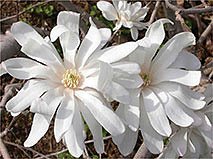
Gardening News: Magnolis Stellata
April The sweet smell of spring should now be evident in all our gardens. Our lawns may even have had their first trim of the year. It’s a cracking time of year with so many plants sending their new fresh growth skywards, with the changes in the garden noted almost daily. It’s also a time to ensure that your garden is ready for summer too. Any unfinished jobs that you didn’t get around to during the winter, should be done now to ensure that you are well prepared and ready for what the next few months may bring.Plant of the Month: Magnolis Stellata.
Everyone loves a magnolia in full flower, so much so that many of us are tempted to plant one only to find out we don’t have the room to let them grow to their mature size. It is of course when they reach maturity that their displays are at their best. A harshly pruned magnolia which is kept trimmed to stop it taking over the garden, can often look very sorry for themselves.
There are varieties that are better suited to the smaller garden, Magnolia Stellata being one of them. This small tree / large shrub creates a wonderous spring display of beautiful white, starry shaped flowers. Here in the cool climate of the UK it can reach about 3 metres, making it an ideal addition to any planting scheme.
Magnolia Stellate originates from Japan, where it grows around the Ise Bay especially in the Kaisho Forest near Nagoya. Many Magnolia varieties have been introduced into our gardens and the cultivation of magnolias in gardens dates back to at least 600 AD, with records showing that they were popular in large Chinese gardens. They are one of the oldest plant groups still in existence today and date back at least 20 million years, evolving before bees did and evolution has formed them so that they encourage pollination by beetles and not bees or moths.
Magnolias prefer full sun throughout the year but will also grow well in light shade for part of the day. Some varieties are well suited to growing in containers however they grow best in soil which is slightly acidic or neutral, they do not do well in alkaline, chalky soils. They are shallow rooting plants, so it’s best not to disturb them once they are established. They will also tolerate neglect well, as they grow well with minimal pruning and not a lot of fuss. If you do need to prune them, it should be done immediately after flowering to ensure that you don’t lose the flowers the following year.
Jobs to be doing this month include:
Ornamental Garden:
• Continue to remove faded flowers on spring bulbs but not the foliage until it is withered.
• Keep borders weed free.
• Mulch borders if not completed last month.
• If the weather is mild then trim weak or straggly growth of sage and rosemary.
• Penstemons – Cutback last year’s stems down to the new growth – if the weather is very cold delay until end of the month.
• Check evergreens for any frost damage – lightly prune if necessary.
• Look out for early aphid attacks and treat if necessary.
• Sweet Peas can be direct sown now to produce plants that flower later than those sown under glass or over wintered plants.
• Prune early flowering shrubs such as forsythia etc.
• To ensure strong growth on roses apply general fertiliser.
• Plant evergreen trees and shrubs / move existing evergreens if necessary.
• Trim back frost damaged foliage.
• Plant summer fruiting corms and tuberous plants including dahlia, gladioli and canna.
• Apply combined feed, with moss and weedkiller to lawns if necessary.
Vegetable Garden:
• Continue planting potatoes and finish planting onion setts by mid-April.
• Direct sow veg such as beetroot, carrots, lettuce, radish, turnip, peas, spinach and parsnip.
• Prune young stone fruit trees such as cherries and plums as leaf buds open.

